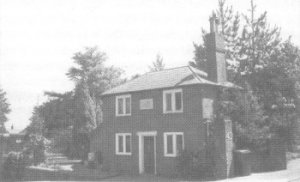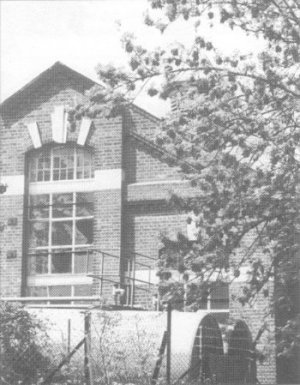Trust Member's Choice - TrustNews Summer 1996
Members of the Trust - a few names taken at random - were invited to select a building, a garden, a sculpture, or some special corner of Winchester that they liked, and describe what it was about it that particularly appealed to them. There was a good response, and three examples are included here. Further 'special corners' from members would be greatly welcomed, so if anyone is interested in contributing to a future newsletter, please write to the Editor.
St James Catholic Cemetery, Romsey Road

St James Catholic Cemetery, Romsey Road
Regine Tatham writes:

The immaculately kept Gate - keeper's lodge
If you walk up the Romsey Road towards Hilliers from Upper High Street, past the long high wall of the water tower (a green bench is set in a niche half-way up for the weary) there is, on the left, a tiny, immaculately kept gate-keeper's lodge which stands guard over the old Catholic Cemetery of St James. Go through a double set of wrought iron gates into one of the only three recorded graveyards attached to a Saxon Church in the Middle Ages. You haven't come here for a history lesson, but there is one attached to the outside wall of the larger of the two mausoleums. Flanked on each side by hospital buildings and the hum of the Romsey Road traffic, it is nevertheless one of the quietest, most deserted, most peaceful places in Winchester with just that mixture of care and neglect that one expects of the best graveyards. The grass is mown, only in the right places, and there are fresh flowers on some of the graves. There used to be a lovely view, now mostly obscured by the new Hospice being built up Mews Lane, but if you stand with your back to the furthest wall of the Grace family mausoleum, you can still see St Catherine's Hill in the distance; you can wander among the graves of an Archbishop, a Bishop, French refugees fleeing the Revolution, Parish Priests, members of the nobility and humbler folk and, remembering a section of the community much persecuted in its day, do as you are asked and "in your charity pray for them all".
Water Garden, Water Close, off Colebrook Street

Water Garden, Water Close, with the Cathedral in the background
This was chosen by two members, Mrs Beatrix Brooking and Mrs Barbara Hall. Barbara Hall writes:
When the Hampshire Gardens Trust had its Landscape Fair in the Great Hall in 1993, I was involved in leading some Garden Walks. This included walking through the Water Close Garden which I knew Sir Peter Smithers, former MP for Winchester, had created. By a stroke of luck I discovered his Swiss address, wrote to him and had a kind letter in return telling the details of its making. In the early 1950s he bought the five very small 19th century houses on the site which were already condemned. He had them demolished and with the help of Wilfred Carpenter Turner, the then Cathedral Architect, he developed the site, not only for himself (he was living in Colebrook House at the time) but mainly for the benefit of the general public, walking that way through to the Cathedral.
The wrought iron railing was designed by Wilfred Carpenter Turner, who also found the two stone finials in a builder's yard. The Cypress trees Sir Peter put there for he said a monk might well have brought the seed back from Rome! The stream, which provides occasional haven for a pair of ducks, passes on into the garden of Colebrook House, where it descends a "water staircase" of four steps - the "best Birds Public Baths in Winchester", as Sir Peter put it. The garden itself always has something of interest - arum lilies, the roses and the magnolia tree which leads the eye onwards to a very special glimpse of the East End of the Cathedral. How lucky we are that Sir Peter had the generosity of mind to create this beautiful and peaceful spot for us, the citizens of Winchester and visitors alike.
I have often wondered whether the present owner of Colebrook House would grant his permission for a plaque to be put there, naming it The Smithers Garden, to join the Scott Garden and the Joyce Garden elsewhere in the City.
A Special Approach to Winchester

Approaching the Pumping Station

A detail of the Pumping Station
David Woods writes:
To suggest that a small road past a rubbish dump should make the most fitting approach to Winchester may seem eccentric, for an entrance should herald its objective, and the City, with its great and ancient buildings, lacks any avenue of echoing architectural pomp or stateliness. But Gamier Road, by a mixture of charm and magic, provides an entirely fitting welcome to ambler and motorist alike.
Winding out of the downland this country lane squeezes over the several flows of the Itchen and through its bordering hawthorn and willow gives views of the water meadows stretching north to the heart of the City. Passing a couple of mellow cottages all remains essentially rural until, improbably signalled by the entrance to the Recycling Centre (a place of manifold delights and a recommended outing in itself), one suddenly enters a massive nave of towering poplars whose shade conceals the City Pumping Station. Built in 1878, this proud Victorian building's functional stature is lightened by tall arched windows and topped by an incongruous blue potting-shed structure - mass leavened by light and wit.
The effect is theatrical but one has undeniably been ushered into the City, unexpectedly prepared by a cameo of scale and shade for the Cathedral and all that awaits.
